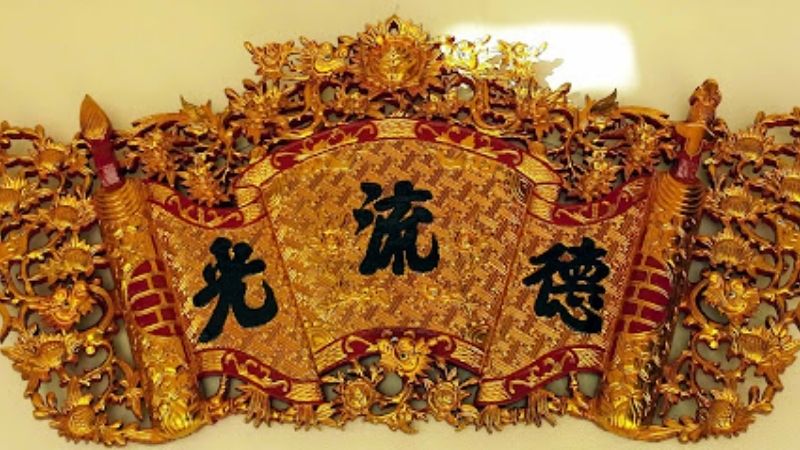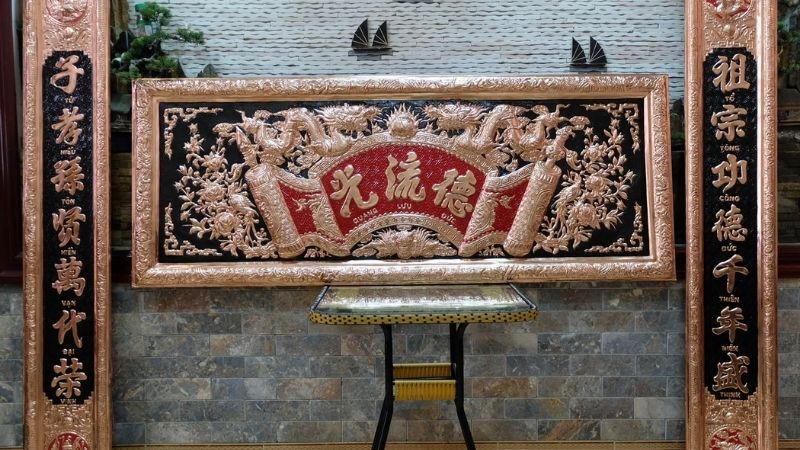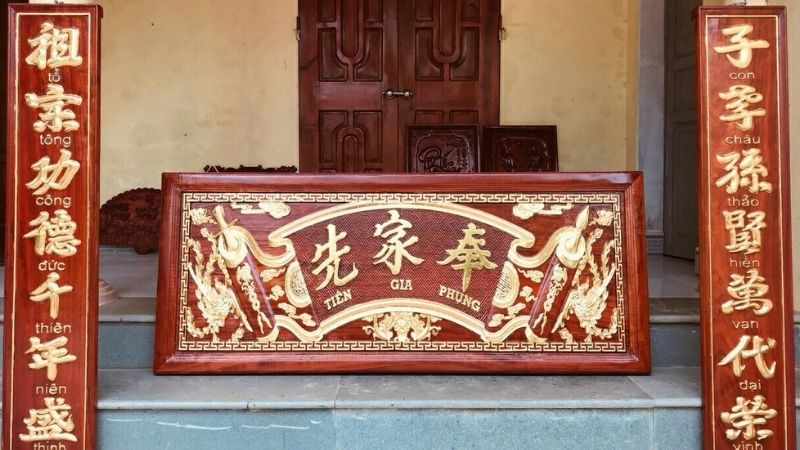Scrolls are decorative pieces, especially in wooden houses, adding an air of mystery and beauty. However, the meaning of the words on these scrolls is often understood only by their owners. Today, let’s explore their significance further.
1 What is a Scroll?
A scroll is a horizontal plaque, resembling a painting or calligraphy, written in Chinese characters and typically hung above an altar.
Its layout usually features a central panel with calligraphy, resembling an ancient Chinese scroll often seen in period dramas.
 What is a Scroll?
What is a Scroll?
On either side of the scroll are a pen and a sword, symbolizing knowledge and strength. The scroll is further adorned with intricate dragon and phoenix motifs, exuding elegance, mystery, and power.
2 What are Hoanh Phi and Cau Doi?
Hoanh Phi and Cau Doi are two rectangular wooden plaques symmetrically placed on either side of an altar. Hoanh Phi usually features simple patterns, with the focus being on the calligraphy and the implied meaning.
 What is Hoanh Phi?
What is Hoanh Phi?
Hoanh Phi conveys a positive message, reflecting the ancestors’ teachings or philosophies on morality, ethics, and interpersonal relationships.
Whether worshipping deities, ancestors, or both, Hoanh Phi and Cau Doi are carefully chosen to convey a meaningful message that aligns with the revered entity.
3 The Significance of Scrolls and their Inscriptions
Historically, scrolls and Hoanh Phi served as room dividers, providing privacy and separating spaces.
Additionally, scrolls were presented as gifts during important ceremonies, such as longevity celebrations, ancestor worship, or housewarmings. The intricate dragon and phoenix motifs made them cherished gifts for both the giver and receiver.
 The Significance of Scrolls and their Inscriptions
The Significance of Scrolls and their Inscriptions
Today, scrolls and Hoanh Phi are predominantly used in altars, with their elegant and traditional aesthetics, along with the pen and sword imagery, symbolizing strength and power. They are believed to ward off negative energies and purify the worship space.
The inscriptions on the scrolls are of utmost importance and are carefully chosen. Common phrases include: “Phúc Lộc Thọ” (Blessing, Prosperity, Longevity), “Phụng Gia Tiên” (Honoring Ancestors), “Đức Lưu Quang” (Everlasting Virtue), “Phúc Mãn Đường” (Abundance of Blessings), “Thiện Tối Lạc” (Greatest Joy in Doing Good), “Phúc Lai Thành” (Blessings for the Clan), and “Ngũ Phúc Lâm Môn” (Five Blessings at the Doorstep: Wealth, Honor, Longevity, Health, and Peace).
4 How to Properly Hang Scrolls, Hoanh Phi, and Cau Doi on an Altar
Scrolls and Hoanh Phi are typically hung in worship rooms, such as ancestral halls, clan houses, or traditional wooden altars.
The scroll should be hung above the altar, with the center of the scroll aligned with the incense burner. The bottom of the scroll should be about 80-100 cm from the altar’s surface, and the scroll should be tilted downwards by 20-30 degrees for better visibility.
Hoanh Phi and Cau Doi should be placed symmetrically on either side of the altar, lower than the scroll, and flush against the columns or walls.
We hope this guide has provided you with a deeper understanding of scrolls, Hoanh Phi, and Cau Doi, and how to incorporate them into your home decor.
Uncover the secret Feng Shui master’s tips for decluttering your home to invite wealth and abundance in the Year of the Ox 2021.
With the Lunar New Year approaching, every family is busy shopping and tidying up their homes to welcome the new year with a fresh start. However, according to Feng Shui beliefs, it is important to clean the house at the end of the year in a way that aligns with good Feng Shui principles and avoids any Feng Shui taboos that could potentially bring negative energy and affect the overall luck of the family in the new year. This knowledge is not widely known to everyone.



































